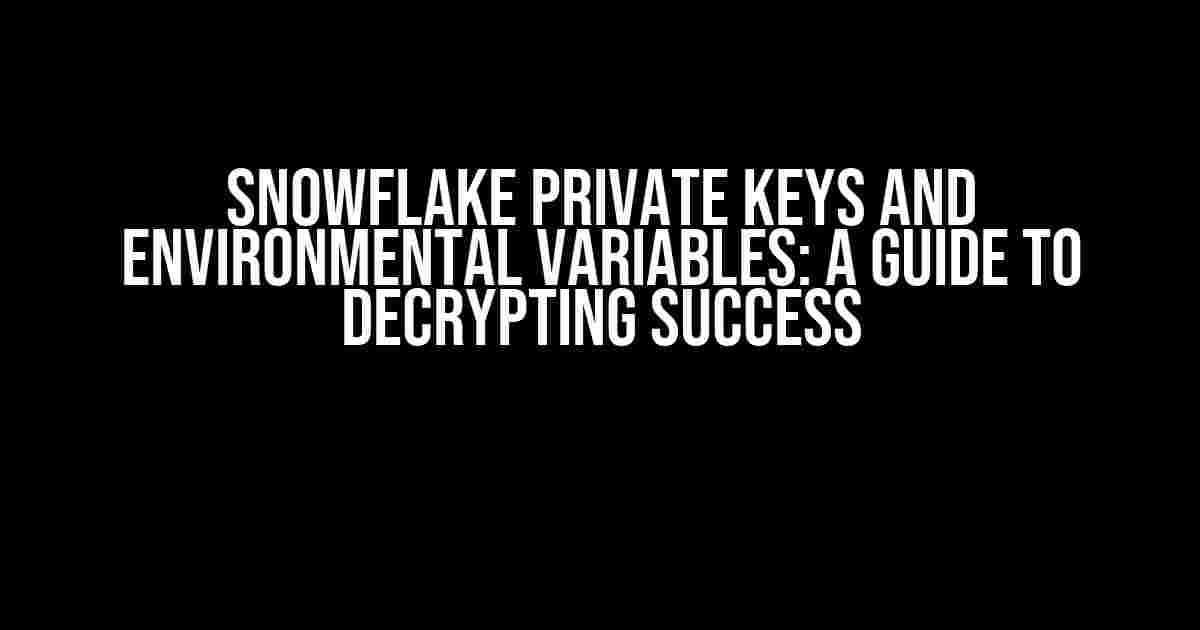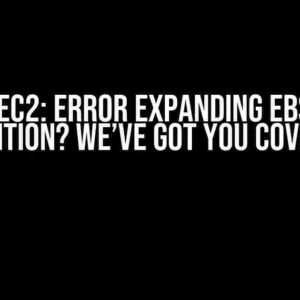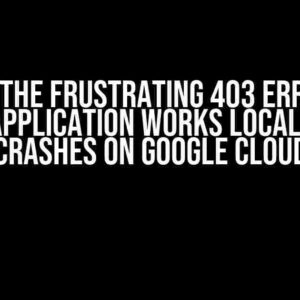- The Problem: Unable to Decrypt with Snowflake Private Keys and Environmental Variables
- Common Errors: Why You Can’t Decrypt with Snowflake Private Keys and Environmental Variables
- Step-by-Step Guide to Decrypting with Snowflake Private Keys and Environmental Variables
- Additional Tips and Best Practices
- Conclusion
The Problem: Unable to Decrypt with Snowflake Private Keys and Environmental Variables
Are you struggling to decrypt your Snowflake private keys using environmental variables? You’re not alone. Many developers and data engineers face this challenge, and it’s a critical hurdle to overcome in data pipelines. In this article, we’ll delve into the world of Snowflake private keys and environmental variables, exploring the reasons behind decryption issues and providing step-by-step solutions to get you back on track.
Understanding Snowflake Private Keys
Snowflake private keys are essential for secure data encryption and decryption. When creating a Snowflake account, you’re provided with a pair of keys: a public key and a private key. The public key is used for encryption, while the private key is used for decryption. It’s crucial to keep your private key safe and secure, as losing it can result in data loss and security breaches.
Environmental Variables: The Missing Piece
Environmental variables play a vital role in decrypting Snowflake private keys. These variables store sensitive information, such as usernames, passwords, and private keys, allowing you to access Snowflake resources securely. Environmental variables can be set at the system level or within your application, making it easier to manage and rotate private keys.
Common Errors: Why You Can’t Decrypt with Snowflake Private Keys and Environmental Variables
Before we dive into the solutions, let’s explore common errors that might be preventing you from decrypting with Snowflake private keys and environmental variables:
- Incorrect private key format: Snowflake private keys must be in PEM format.
- Invalid environmental variable naming: Environmental variables must follow specific naming conventions.
- Incorrectly set environmental variables: Environmental variables must be set correctly at the system or application level.
- Mismatched public and private keys: Ensure your public and private keys are correctly paired.
- Key rotation issues: Failing to rotate private keys can result in decryption errors.
Step-by-Step Guide to Decrypting with Snowflake Private Keys and Environmental Variables
Now that we’ve covered the common errors, let’s walk through a step-by-step guide to decrypting with Snowflake private keys and environmental variables:
Step 1: Generate a Snowflake Private Key in PEM Format
Generate a new Snowflake private key in PEM format using the following command:
openssl genrsa -out snowflake_private_key.pem 2048Alternatively, you can use an existing private key in PEM format.
Step 2: Set Environmental Variables
Set the following environmental variables at the system or application level:
| Variable Name | Value |
|---|---|
| SNOWFLAKE_PRIVATE_KEY | Path to your Snowflake private key file (e.g., /path/to/snowflake_private_key.pem) |
| SNOWFLAKE_ACCOUNT | Your Snowflake account name |
| SNOWFLAKE_USERNAME | Your Snowflake username |
For example, in a Linux or macOS environment, you can set environmental variables using the following command:
export SNOWFLAKE_PRIVATE_KEY=/path/to/snowflake_private_key.pem
export SNOWFLAKE_ACCOUNT=my_account
export SNOWFLAKE_USERNAME=my_usernameStep 3: Configure Your Snowflake Connection
Configure your Snowflake connection using the following Python code:
import snowflake.connector
# Initialize Snowflake connection
conn = snowflake.connector.connect(
user=os.environ['SNOWFLAKE_USERNAME'],
password=None,
account=os.environ['SNOWFLAKE_ACCOUNT'],
private_key=os.environ['SNOWFLAKE_PRIVATE_KEY']
)
# Create a cursor object
cur = conn.cursor()
# Execute a query to test the connection
cur.execute('SELECT 1')
results = cur.fetchall()
print(results)If you’ve followed the steps correctly, you should be able to decrypt your Snowflake private key using environmental variables.
Additional Tips and Best Practices
To ensure secure and successful decryption with Snowflake private keys and environmental variables, follow these additional tips and best practices:
- Rotate your private keys regularly to maintain security.
- Use secure storage for your private keys, such as a Hardware Security Module (HSM) or a secure file system.
- Limit access to your private keys and environmental variables to authorized personnel only.
- Use secure protocols for data transmission, such as HTTPS or SFTP.
- Monitor your Snowflake accounts and pipelines for any signs of unauthorized access or decryption issues.
Conclusion
Decrypting Snowflake private keys using environmental variables can be a complex process, but by following the steps outlined in this article, you should be able to overcome common errors and achieve successful decryption. Remember to rotate your private keys regularly, use secure storage, and limit access to authorized personnel to maintain the security of your Snowflake resources.
By mastering Snowflake private keys and environmental variables, you’ll unlock the full potential of your data pipelines, ensuring seamless data encryption and decryption for your organization.
Additional Resources
For further guidance on Snowflake private keys and environmental variables, explore the following resources:
- Snowflake Documentation: Connection Parameters
- Snowflake Documentation: Account Identifier
- Stack Overflow: Snowflake Private Key Decryption
FAQs
Frequently asked questions and answers about Snowflake private keys and environmental variables:
| Question | Answer |
|---|---|
| What is the recommended format for Snowflake private keys? | PEM format is the recommended format for Snowflake private keys. |
| Where should I store my Snowflake private key? | Store your Snowflake private key in a secure location, such as a secure file system or a Hardware Security Module (HSM). |
| How often should I rotate my Snowflake private key? | Rotate your Snowflake private key every 90 days or as per your organization’s security policy. |
Frequently Asked Question
Get the answers to your most pressing questions about Snowflake private keys environmental variables unable to decrypt!
Why am I getting an error when trying to decrypt my Snowflake private key?
This might happen if your Snowflake private key is not correctly set as an environmental variable. Double-check that you’ve set the `PRIVATE_KEY` variable correctly and try again!
What’s the correct format for setting Snowflake private key as an environmental variable?
The correct format is to set the `PRIVATE_KEY` variable to the contents of your private key file, starting from `—–BEGIN RSA PRIVATE KEY—–` to `—–END RSA PRIVATE KEY—–`. Make sure to include the newline characters (`\n`) in the variable value!
Can I use a PEM file for my Snowflake private key instead of an environmental variable?
Yes, you can! Snowflake supports PEM files as an alternative to environmental variables. Just make sure to specify the path to your PEM file correctly, and Snowflake will take care of the rest!
How do I troubleshoot issues with decrypting my Snowflake private key?
Try checking the Snowflake documentation for troubleshooting steps specific to your error message. If that doesn’t help, reach out to Snowflake support or your organization’s IT department for further assistance!
Are there any security best practices I should follow when handling Snowflake private keys?
Absolutely! Treat your Snowflake private key with care, and keep it confidential. Avoid sharing it with anyone, and store it securely in a secrets manager or encrypted storage. Remember, your private key is the key to your Snowflake kingdom!




